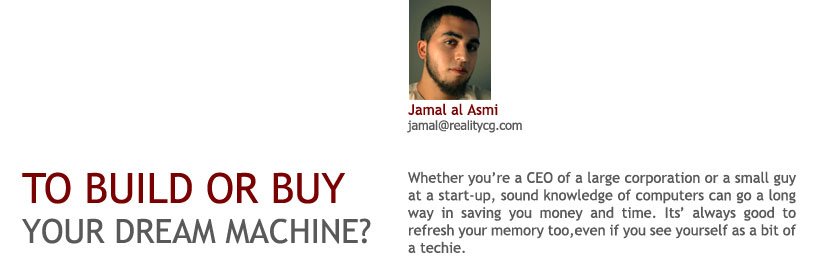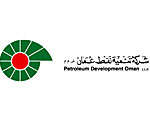Jamal Al Asmi is Production Manager at Reality CG
URL: www.realitycg.com

As a reader of Digital Oman, you can likely claim to know something about these electronic boxes - they have an on/off button, the tray that comes out of the front isn't a cup-holder and the blue-screen which stops you from being able to use the mouse and keyboard, isn't a pretty screensaver.
Considering that the average lifespan of a PC is around four years, then for frequent PC users this equates to a whopping 10,000 hours or more of interaction. That's more time than you probably spend with your family over a similar period of time. But the fact remains - for a device that we're all so reliant on, the PC is still alien to the vast majority of users and purchasing the right one can be more painful than a trip to the dentist. So, let's refresh our memories and look at some of the options available to us.
The five main components of a PC are:
1. CPU - The heart and brains of the computer, the Central Processing Unit is responsible for making all the decisions and processing that your computer makes, so it's paramount to get it right. Let's consider some basic CPU buying principles that should hold true for the next five years:
» Choose a processor that hasn't been on the market for more than two years. Never buy a CPU that's more than four years old as it'll either be unable to run your operating system or be too slow to run useful applications.
» If you're trying to decide between two or three CPUs of the same brand then I suggest you calculate the MHz per RO for each CPU to determine which offers you the best value.
» Never buy the very best CPU on the market. You'll fall foul to the price drop and it's a long fall - the most expensive CPUs tend to loose about 40% of their value in the first six months.
» Visit an online tool. If you prefer as many of us do, performance charts to guide your purchase decision, then visit www.tomshardware.com and check out its 'Interactive CPU Charts' tool. This'll help your decision making process.
2. Motherboard - If we're going to stay in keeping with the human body analogy then the motherboard has to be the nervous system. The motherboard contains all the connectors and sockets that all the other components within the system plug into.
You should base your motherboard on a compatible CPU. Opt for an AMD compliant motherboard if paring with an AMD CPU or an Intel motherboard if pairing with an Intel CPU. Choose a motherboard with a socket that fits your new processor by checking that the socket name of your processor matches the socket name on the motherboard. From here it's all about features that include connectivity ports, network features, graphics and sound capabilities, as well as a host of other features that are beyond the scope of this article.
3. RAM - This isn't what you do to your PC when it's not working, rather it's the fast memory that gives your computer a temporary place to process electronic data. At least 512MB is recommended for almost all current applications. Video editors, budding graphics artists and gamers should credit their systems with more.
4. Graphics Card - The graphics card is responsible for much of the processing that you see, and a crucial component in any 3D artist's tool box. A better graphics card often equates to smoother video playback, greater 3D performance and will often give you the support for higher resolution monitors. There are two Kings of the Hill in the graphics arena: Nvidia and ATI, both of which come in various flavours for your viewing pleasure. Cards are currently either AGP or PCI-Express based and these socket types will have to be available on your motherboard to enjoy these cards. PCI-Express promises greater bandwidth and performance potential than its AGP counterpart.
5. Hard Disk - The hard disk is where your OS and applications are installed. Today, most hard disks are PATA based, but SCSI and SATA offer better performance. SATA in particular is the way to go as it offers speed, value and convenience, but ensure your motherboard has SATA connectors first. Don't worry too much about brand as there are few players on the market and little differentiates them. There is wisdom in opting for a drive with 8MB Cache or more as it'll offer greater read/write performance.
Buy or Build?

You only have three choices when deciding on a PC, and it frankly depends on your level of interest and what you consider most important:
Buy a Brand - Companies such as Dell, Hewlett Packard, Lenovo, Acer, Compaq and Mac would welcome you as a customer. They're a safe bet, their PCs are well equipped, work straight out of the box, offer you customer support, warranty and come loaded with pre-installed software. For the faint hearted, this is your only choice as you're almost 100% guaranteed it'll work from day one, and if it doesn't, at least you can call one of the help lines for tech support. The disadvantage is that you don't get the fun and thrills of building it, you won't learn a whole lot about PCs and you become reliant on your supplier. Because branded PCs tend to use proprietary parts, you're forced to pay for expensive replacements in event of component failure.
Build a Clone - And it doesn't have to be a sheep, it can be a PC based on your favourite branded model. Substitute the proprietary components for other components and copy the remaining specification of the branded computer. Once you have your system down on paper, take the design to one of the many local system assemblers and they'll build it for you. The plus points here are that you'll end up saving cash as you aren't paying through the nose for customer service and you'll gain some independence. This route doesn't always offer the cushion of solid customer service or a nicely packaged warranty. Oh well, you can't always have your cake and eat it, can you?
Build a Frankenstein - Building your own PC can be a satisfying and rewarding experience, especially when you bring it to life for the very first time and all the vital signs are there. But it isn't for everyone. Thankfully, this isn't gothic science fiction as there are plenty of resources online that can help safeguard you from failure. The advantages of building your own PC are that it's educational, allows you to tailor to your own requirements and you'll save money. The disadvantage to all of this is that it can be a lengthy process particularly for first timers, both warranty and compatibility of components can be an issue and you need to spend time researching. But there are few substitutes for those looking to learn about computers and save cash. Here you truly can have your dream machine, without the monster fees.
Get Closer!
It's hard for most of us to think of life without a computer. Indeed, hardware manufacturers, resellers and marketers need to seriously address this issue of consumer bafflement and users need to take a little time out to better understand how their new found friend ticks.








